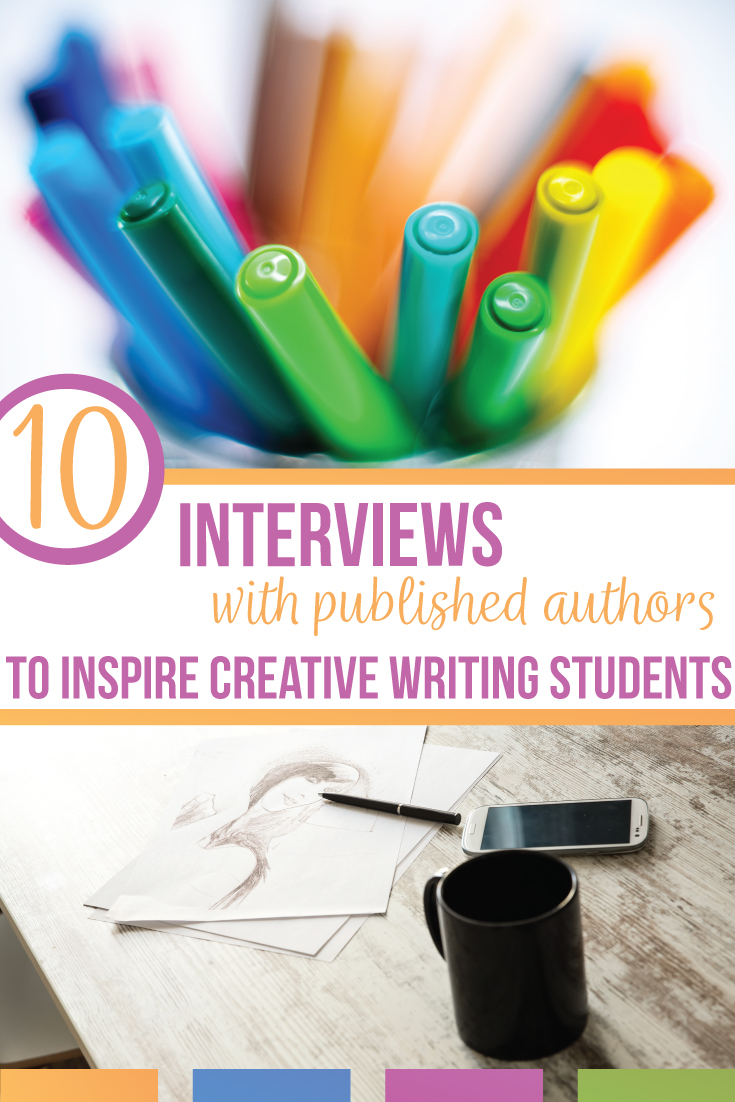Looking to inspire creative writing students? Read on for reading material and lesson plan ideas.
Students enjoy outside sources; they view them as inside secrets or adult-like. Perhaps they are more authentic than readings in textbooks.
As I build my creative writing lessons, I continue to build mentor texts into the class. I also incorporate writers talking about writing.
Why?
Well, as I continue to teach, the more I realize that students honestly believe writing is done in a single act. They think they can’t write because they don’t produce a product in one sitting.
When students realize that writing is a lengthy process, our real work can begin. Looking at real authors and what those authors say about writing encourages students because they realize that writing involves struggle.
I’m a tad obsessed with finding writing tips on Pinterest and Facebook for myself. As I sort through top ten lists and articles, I began thinking that many would work with older students, maybe in a creative writing class. Below, I’ve included ten articles to inspire creative writing students to help students discover how published authors write. You then can encourage creative writing students to find their own writing process.
Jason Reynolds
I love this interview with Jason Reynolds because he uses analogies that are accessible to everyone. He also like how he says that he is his own competition. That inspires me, and I hope students see it that way too.
Amy Tan
I adore that Amy Tan speaks honestly about writing. She has said before that she would never publish anything if she waited for it to be perfect. In this interview, she also covers writing disasters and moving forward. It’s important to share with students that reworking and rediscovering a piece is a process.
George Orwell
Awww, Eric. He provides a list of questions that students could perhaps run through if they are attempting a change in their writing style. His process is at the very least, interesting. Sometimes, it is helpful to understand what is helpful and what is not for your personal writing process.
Margaret Atwood
Atwood suggests that writers write every day, even if the writing is terrible. My message to students is the same, and it helps to have a professional say it too.
John Steinbeck
Prepare never to finish? Yikes. He has a point, though. Rarely does an author believe a piece of writing is perfect. Acknowledging that may make students more confident.
(This website also has numerous other writers in a series. Perhaps students could choose other authors if Steinbeck isn’t for them.)
Rick Riordan
One way to inspire creative writing students is to show them the struggles a beloved author from the youth has. In this interview, Rick Riordan covers his thoughts on boring literature. Students love the Percy Jackson series, and they always relate to Riordan’s honesty.
Stephen King
Stephen King has a few naughty words in this piece, so you may want to warn students or print the piece out and black them out. He’s prolific and has time-allocating tips, which students so often need.
Maya Angelou
When Maya Angelou passed, I knew that the creative writer who inspired so many left behind brilliance about writing. I like that she said people can write poetry, but they maybe won’t.
Khaled Hosseini
Some writers have a forward path to writing, often with an outline. Khaledosseini starts with an image and lets the writing lead him. In his interview, Hosseini shows that every process is different. As a creative writing teacher, I want to support students as they discover their processes.
Angie Thomas
Finally, Angie Thomas is honest about rejection. I like sharing that article with students because students who wish to become writers often enroll in a creative writing course. Writing for a living is possible, but it requires stamina. Success is rarely immediate, but as Thomas explains, perseverance is key.

Incorporating these articles and interviews into a writing lesson plan? I would do a jigsaw activity. Divide students into groups, assign each group an article, and have them present their findings to the class. Discuss which tips students would like to attempt and which ones do not seem applicable. Perhaps set individual goals or stretch past their comfort zones.
Another writing lesson plan idea? Often in writing classes, students complain when I assign them reading. (They’re goofy like that.) Since many of these authors explain that reading improves one’s writing, reviewing these tips would make for a nice introduction to a larger reading assignment.
These would also work for a substitute lesson plan. Instead of group work (subs may not feel comfortable), ask students to pick one of the above articles and write a brief summary and ideas to implement in their own writing. Have them present their findings when you return.
I’ve found that the best part of these articles is that they weren’t written specifically for high school students. Students appreciate that, the reading of adult material. When we teachers see them as serious writers and provide them with material as young adults, class flows. Student buy-in increases.
How would you incorporate these articles into your writing lesson plans? Could you use these as bell ringers with your creative writing students? I always like to see what works for other teachers.
Those are my six quick tips for teaching grammar. With a few changes, you should be able to use these across multiple grades.

